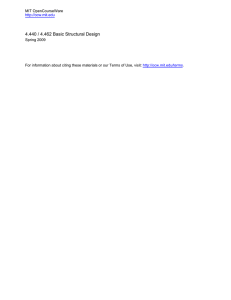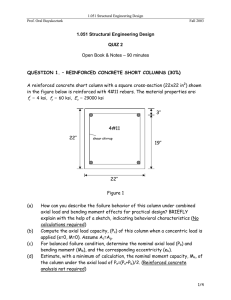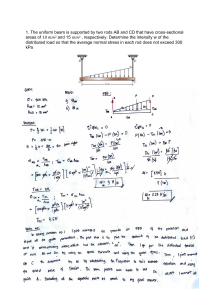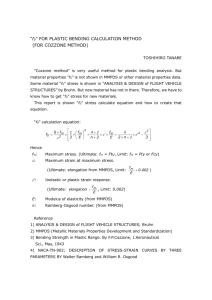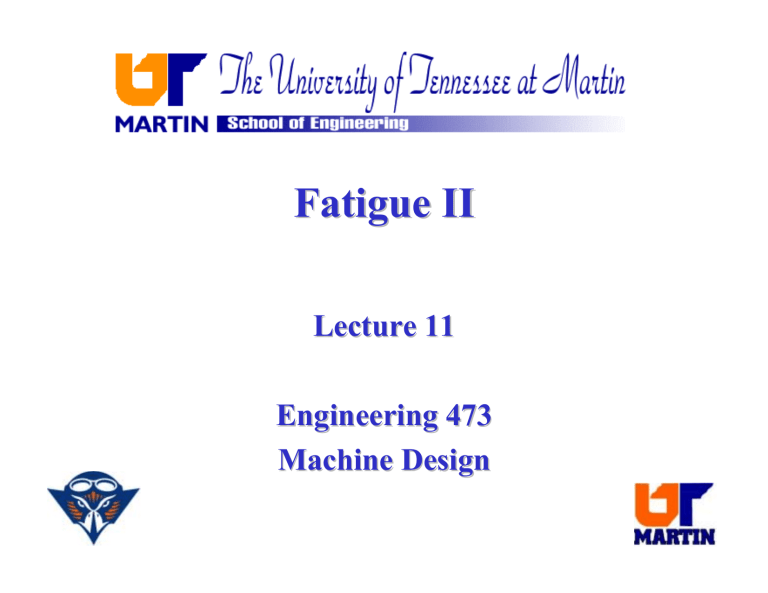
Fatigue II Lecture 11 Engineering 473 Machine Design Finite Life Estimates Alternating S yt Stress, σ a Se How can the life of a part be estimated if the mean stressalternating stress pair lie above the Goodman line? Finite Life (Cycles to failure?) Infinite Life Stress State Mean Stress, σ m S yt Goodman Diagram Sut S-N Curve The S-N curve gives the cycles to failure for a completely reversed (R=-1) uniaxial stress state. What do you do if the stress state is not completely reversed? Completely reversed cyclic stress, UNS G41200 steel Shigley, Fig. 7-6 Definitions Stress Range σ r = σ max − σ min Alternating Stress σ max − σ min σa = 2 Mean Stress Stress Ratio σ min R= σ max Amplitude Ratio σa A= σm σ max + σ min σm = 2 Note that R=-1 for a completely reversed stress state with zero mean stress. Fluctuating-Stress Failure Interaction Curves The interaction curves provide relationships between alternating stress and mean stress. When the mean stress is zero, the alternating component is equal to the endurance limit. The interaction curves are for infinite life or a large number of cycles. Shigley, Fig. 7-16 Goodman Interaction Line k f Sa S m + =1 Se Sut Any combination of mean and alternating stress that lies on or below Goodman line will have infinite life. Factor of Safety Format k f Sa Sm 1 + = Se Sut N f Note that the fatigue stress concentration factor is applied only to the alternating component. Master Fatigue Plot Constant cycles till failure interaction curves. Shigley, Fig. 7-15 Equivalent Alternating Stress σa σ m =0 Alternating S yt Stress, σ a Se Alternating stress at zero mean stress that fails the part in the same number of cycles as the original stress state. 105 cycles 106 cycles Mean Stress, σ m S yt Sut The red and blue lines are estimated fatigue interaction curves associated with a specific number of cycles to failure. Number of Cycles to Failure Once the equivalent alternating stress is found, the S-N curve may be used to find the number of cycles to failure. Equivalent Alternating Stress Formula k f σa σm 1 + = Se Sut N f k f σa σm 1 + = σ a σ =0 Sut N f m σa σ m =0 k f σa = 1 σm − N f Sut Goodman Line σa σ m =0 ≡ Equivalent completely reversed (R = -1) stress that causes fatigue failure in the same number of cycles as the original σ a and σ m pair. Example 5 in 1 5 in Pmax = 3000 lb 2 Pmin = 2000 lb 1.5 in. dia. 0.875 in. dia. 0.125 in. rad. π 4 π 4 D 1 = (1.5) = 0.249 in 4 I1 = 64 64 π 4 π 4 I2 = D 2 = (0.875) = 0.088 in 4 64 64 Material UNS G41200 Steel Notch sensitivity q=0.3 I1 0.249 in 4 S1 = = = 0.332 in 3 c1 0.75 in I 2 0.088 in 4 S2 = = = 0.201 in 3 c 2 0.438 in Example (Continued) 5 in 1 5 in Pmax = 3000 lb 2 Pmin = 2000 lb 1.5 in. dia. 0.875 in. dia. 0.125 in. rad. kf −1 q= k t −1 k f = 1 + q(k t − 1) D 1.5 in = = 1.71 d 0.875 in r 0.125 = = 0.143 d 0.875 Ref. Peterson Material UNS G41200 Steel Notch sensitivity q=0.3 k t = 1.61 k f = 1 + q(k t − 1) = 1 + 0.3(1.61 − 1) = 1.18 Example (Continued) 5 in 5 in 1 Pmin = 2000 lb 2 1.5 in. dia. 0.875 in. dia. 0.125 in. rad. Section 1 (Base) σ max M1 (3000 lb )(10 in ) = = = 90.4 ksi 3 S1 0.332 in σ min = Pmax = 3000 lb M1 (2000 lb )(10 in ) = = 60.2 ksi 3 S1 0.332 in Material UNS G41200 Steel Notch sensitivity q=0.3 σ max − σ min σa = = 15.1 ksi 2 σ max + σ min σm = = 75.3 ksi 2 Example (Continued) 5 in 1 5 in Pmax = 3000 lb 2 Pmin = 2000 lb 1.5 in. dia. 0.875 in. dia. 0.125 in. rad. Section 2 (Fillet) σ max M1 (3000 lb )(5 in ) = = = 74.6 ksi 3 S1 0.201 in σ min = M1 (2000 lb )(5 in ) = = 49.8 ksi 3 S1 0.201 in Material UNS G41200 Steel Notch sensitivity q=0.3 σ max − σ min = 12.4 ksi 2 σ max + σ min σm = = 62.2 ksi 2 σa = Example (Continued) Sut = 116 ksi S′e = 30 ksi = Se k f σa σm 1 + = Se Sult N f Completely reversed cyclic stress, UNS G41200 steel Shigley, Fig. 7-6 Example (Continued) Section 1 (Base) σ max (3000 lb)(10 in ) = 90.4 ksi M = 1= S1 0.332 in 3 σ min = M1 (2000 lb )(10 in ) = = 60.2 ksi 3 S1 0.332 in Sut = 116 ksi S′e = 30 ksi = Se k f σa σm 1 + = Se Sult N f σ max − σ min σa = = 15.1 ksi 2 σ max + σ min σm = = 75.3 ksi 2 Nf = 1 1.0(15.1 ksi ) 75.3 ksi + = 1.15 30 ksi 116 ksi Part has finite life at base. Example (Continued) Section 2 (Fillet) σ max M1 (3000 lb )(5 in ) = = = 74.6 ksi 3 S1 0.201 in σ min = M1 (2000 lb )(5 in ) = = 49.8 ksi 3 S1 0.201 in Sut = 116 ksi S′e = 30 ksi = Se k f σa σm 1 + = Se Sult N f σ max − σ min = 12.4 ksi 2 σ max + σ min σm = = 62.2 ksi 2 σa = Nf = 1 1.18(12.4 ksi ) 62.2 ksi + = 1.02 30 ksi 116 ksi Part has finite life. Calculation of Equivalent Alternating Stress σa σ m =0 k f σa = 1 σm − N f Sut Base Fillet σ a = 15.1 ksi σ a = 12.4 ksi σ m = 75.3 ksi (1.0)15.1 σ a σ =0 = m 1 75.3 − 1.0 116 = 43.0 ksi σ m = 62.2 ksi (1.18)12.4 σ a σ =0 = m 1 62.2 − 1.0 116 = 31.5 ksi Cycles to Failure Estimate 90 70 50 30 20 10 Base Fillet Multi-axis Fluctuating Stress States Everything presented on fatigue has been based on experiments involving a single stress component. What do you do for problems in which there are more than one stress component? Marin Load Factor, kc Se = k a ⋅ k b ⋅ k c ⋅ k d ⋅ S′e The endurance limit is a function of the load/stress component used in the test. Axial loading Sut ≤ 220 ksi (1520 MPa) ì0.923 ï 1 Axial loading Sut > 220 ksi (1520 MPa) ï kc = í Bending ï 1 ïî0.577 Torsion and shear Alternating and Mean Von Mises Stresses 1. Increase the stress caused by an axial force by 1/kc. 2. Multiply each stress component by the appropriate fatigue stress concentration factor. 3. Compute the maximum and minimum von Mises stresses. 4. Compute the alternating and mean stresses based on the maximum and minimum values of the von Mises stress. 5. Use the Goodman alternating and mean stress interaction curve and S-N curve to estimate the number of cycles to failure. Use the reversed bending endurance limit. Complex Loads A part is subjected to completely reversed σ, F stresses as follows σ1 for n1 cycles, σ2 σ1 σ3 σ 2 for n 2 cycles, t, time σ 3 for n 3 cycles, M σ m for n m cycles, What is the cumulative effect of these different load cycles? Minor’s Rule Cumulative Damage Law n1 n 2 n 3 nm + + +K + =C N1 N 2 N 3 Nm n i ≡ number of cycles for stress level i N i ≡ cycles to failure at stress level i C ≡ Constant ranging from 0.7 to 2.2. C is usually taken as 1.0 Minor’s Rule is the simplest and most widely used Cumulative Damage Law Example Stress Cycles State (n) Life (N) n N 1 1,000 2,000 0.5 2 5,000 10,000 0.5 3 10,000 100,000 0.1 1.1 Part will fail Assignment (Problem No. 1) A rotating shaft is made of 42 x 4 mm AISI 1020 cold-drawn steel tubing and has a 6-mm diameter hole drilled transversely through it. Estimate the factor of safety guarding against fatigue failure when the shaft is subjected to a completely reversed torque of 120 N-m in phase with a completely reversed bending moment of 150 N-m. Use the stress concentration factor tables found in the appendices, and estimate the Marin factors using information in the body of the text. Assignment (Problem No. 2) A solid circular bar with a 5/8 inch diameter is subjected to a reversed bending moment of 1200 in-lb for 2000 cycles, 1000 in-lb for 100,000 cycles and 900 in-lb for 10,000 cycles. Use the S-N curve used in this lecture. Determine whether the bar will fail due to fatigue. Assume all Marin factors are equal to 1.0. Assignment (Problem No. 3) Same as Problem No. 2 except there is a constant axial force of 5,000 lb acting on the bar in addition to the completely reversed bending moment.
